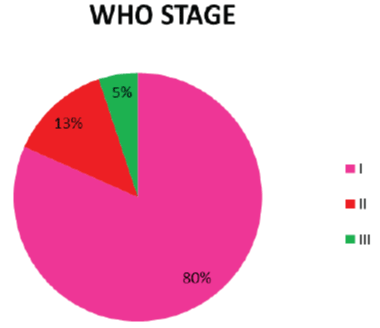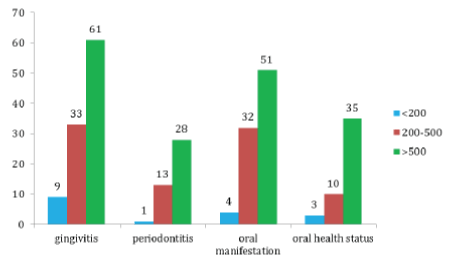Review Article Open Access
Distribution of Oral Manifestation among HIV Patients Attending Art Centers in Chennai
| Krishna Prasanth B1*, Deva Malika MS2, Valarmathy S2, Aravindha Babu N1 and Jinu Merline Koshy3 | |
| 1Department of Oral Pathology (COCPAR), Sree Balaji Dental College, Bharath University, Chennai, India | |
| 2Department of Epidemiology, the Tamilnadu Dr. MGR Medical University, Chennai, India | |
| 3Department of Anatomy, Sree Balaji Dental College, Bharath University, Chennai, India | |
| *Corresponding Author : | Krishna Prasanth Department of Oral Pathology (COCPAR) Sree Balaji Dental College Bharath University, Chennai, India Tel: +0123456789 E-mail: mail2kristain@gmail.com |
| Received date: Nov 12, 2015; Accepted date: Mar 04, 2016; Published date: Mar 07, 2016 | |
| Citation: Krishna Prasanth B, Deva Malika MS, Valarmathy S, Babu NA, Koshy JM (2016) Distribution of Oral Manifestation among HIV Patients Attending Art Centers in Chennai. J Infect Dis Ther 4:272. doi:10.4172/2332-0877.1000272 | |
| Copyright: © 2016 Prasanth KB et al. This is an open-access article distributed under the terms of the Creative Commons Attribution License, which permits unrestricted use, distribution, and reproduction in any medium, provided the original author and source are credited. | |
Visit for more related articles at Journal of Infectious Diseases & Therapy
Abstract
Oral health forms an important aspect of overall general health. Ranging from minor infections to several chronic diseases, oral health can be a first indicator to identify health problems.
HIV infection causes progressive deficiency in the immune system leading to many opportunistic infections and a wide range of oral manifestations.
Oral manifestations have found a place in many classifications and staging related to HIV infection. Many earlier studies on oral manifestation of HIV have been based on western population. Hence a study highlighting the distribution of oral manifestation among HIV patients under ART have been undertaken involving South Indian population.
| Keywords |
| Leukoplakia; Sarcoma; Erythema; Candidiasis; Glossodyniea; Xerostomia |
| Introduction |
| Oral health is regarded as the mirror of general health. From small infections to chronic diseases, the oral cavity is the first indicator to identify health problems. There are several chronic diseases found worldwide, among which HIV Infection poses lot of challenges to the doctors and researchers [1]. |
| The first HIV- AIDS (Acquired Immuno Deficiency Syndrome) case was detected in the United States in 1981, Infection with HIV causes progressive immunodeficiency resulting in a variety of opportunistic infections as well as their oral manifestation. |
| Several reports have identified a strong correlation between HIV infection and various oral lesions like oral candidiasis, hairy leukoplakia, Kaposi’s sarcoma, Non- Hodgkins lymphoma & specific forms of periodontal diseases. Higher prevalence of opportunistic microorganism has been frequently detected in the sub gingival flora of HIV-infected individuals. Periodontal diseases that are most strongly associated with HIV infection include linear gingival erythema, necrotizing ulcerative gingivitis and necrotizing ulcerative periodontitis [2]. |
| This article focuses on the distribution of oral problems (gingivitis, periodontitis), oral hygiene status and the oral manifestation of HIV patients under Anti-Retroviral therapy (ART). |
| Oral manifestations are among the earliest and most important indicators of HIV infection. At present, three groups of oral manifestations of AIDS are defined based on their intensity and features [3]. |
| Group 1 is composed of seven cardinal lesions (oral candidiasis, oral hairy leukoplakia, Kaposi’s sarcoma, linear gingival erythema, Necrotizing ulcerative gingivitis, Necrotizing ulcerative periodontitis, and Non-Hodgkin’s lymphoma) that are strongly associated with HIV infection [4]. |
| Group 2 includes a typical ulcers, salivary glands diseases, viral infection such as cytomegalovirus (CMV), herpes simplex virus (HSV), Human papillomavirus (HPV), and herpes zoster virus (HZV). |
| On Group 3 are lesions rarer than those on groups 1 and 2, such as diffuse osteomyelitis and squamous cell carcinoma. |
| Materials and Methods |
| The oral examination was done using mouth mirror and probe by a single examiner and the periodontal statuses were recorded using Loe and Silness indices. |
| The study was carried out as a cross sectional study among HIV positive patients attending ART centers in Chennai, using purposive sampling. The sample size of 232 was included in the study comprising of adult HIV sero positive patients inclusive of both genders [5]. |
| The Study was duly cleared by the Ethics committee of The Tamilnadu Dr.MGR medical university. |
| Results |
| Totally 232 patients between age 24 to 71 years were examined, among them 130 with mean age (SD)-42.71(9.64) were males and 132 with mean age (SD) 39.71(8.78) were females. |
| Prevalence of gingivitis was 44.4 % which is higher when compared to other oral problems and the prevalence of periodontitis was 18.1% (Table 1). |
| Out of 37.5% cases with oral manifestations, 18.3% suffered from recurrent aphthous ulcer, and melanin pigmentation, 14.9 % cases had distribution of candiasis (Table 2). |
| Among 232 patients screened, 2 were completely edentulous, among them one had denture stomatitis [6]. |
| The below table (Table 3) shows the distribution of oral hygiene status among the participants recruited in this study. |
| The figure (Figure 1) depicts that the majority of the participants reported were at WHO stage 1(CD4 Count >500). |
| The below figure (Figure 2) shows the distribution of several variables such as gingivitis, periodontitis, oral health status and oral manifestations among different level of CD4 count. |
| The table 4 shows that there were no significant (p>0.05) mean difference between the male and female patients as determined by Independent t test. |
| Discussion |
| The most important aspect of the present study was to determine the distribution of oral lesions among patients on ART. The study included almost equal number of participants from both genders which is in concordance with studies done by Mithra N Hegde et al. |
| The study results showed that the distribution of Gingivitis was 44.4%, however the distribution of periodontitis accounted to only 18.1 %. This was contradictory to studies done by Mithra N Hegde et al. As most of the our patients were on ART, immunocompetence was good, hence less number of periodontitis cases were seen as compared to other findings from previous studies investigating HIV associated oral lesion [7]. |
| Periodontal disease manifestations in HIV infected individuals include linear gingival erythema, necrotizing ulcerative gingivitis and necrotizing ulcerative periodontitis and diagnosticians have always associated periodontal diseases especially linear gingival erythema in HIV seropositive patients [8]. Among 232 participants,37.5% exhibited some form of oral manifestation related to HIV infection .18.3 % patients had recurrent aphthous ulcer and melanin pigmentation, 14.9 % were having candidiasis, 17.2 % Leukoplakia cases ,9.1% cases with nicotine stomatitis and angular cheilitis cases and other lesions amounted to 1.1 % (oral hairy leukoplakia, median rhomboid glossitis, glossopyrea, glossodynea). |
| Presence of oral hairy leukoplakia is a fairly reliable indicator of HIV seropositivity and is a predictor of declining immunocompetence. In this study only negligible amount of cases with Oral hairy leukoplakia were seen. This may be justified by the fact that most of the patients were screened from ART centers and exhibited better immunity owing to their medications. |
| We found a close association between the patient’s immune state and the presence of oral candidiasis, with an increase in frequency of oral candidiasis as CD4 count decreased. Most of the cases of oral candidiasis were found in low CD4 count (<200 cells/mm3). Pseudo membranous candidiasis was the most common variant. The periodontal disease occurred in less severe immune suppression with its mean CD4 count being 491. The most common variant linear gingival erythema cases were observed in high CD4 count (>500 CD4 cell/ mm3). We found that hairy leukoplakia was not associated with increasing level of immunosuppression because the presence of this oral lesion did not significantly increase as CD4 cell count decreased. These findings were consistent with the findings of other studies [9]. |
| Several medications used in the treatment of HIV related disease may cause xerostomia. Xerostomia is also associated with increased frequency of candidiasis in patient with HIV infection and it is found in low CD4count (126 cells/mm3) [10]. |
| Conclusion |
| From this study, it is observed that majority of the HIV sero positive patients exhibited milder form of periodontal disease (Gingivitis in 44.4%) and other oral lesions accounted to 37.5% which may be attributed to their better immune status secondary to Anti Retro Viral Therapy. |
| References |
References
- Friedman RB, Gunsolley J, Gentry A, Dinius A, et al. (1991) Periodontal status of HIV-seropositive and AIDS patients. J Periodontol 62: 623-627.
- Coogan MM, Greenspan J, Challacombe SJ (2005) Oral lesions infection with Human Immuno Deficiency Virus. Bull world Health Organ 83: 700-706.
- Essentials of Clinical Periodontology and Periodontics (2008) Second edition Shantipriya Reddy.
- Leao JC, Ribeiro CMB, Carvalho AAT, Frezzini C, Porter S (2009) Oral complications of HIV disease NCBI clinics (Sao Paulo) 64: 459-470.
- Greenspan JS, Greenspan D (2002) The epidemiology of the oral lesions of HIV infection in the developed world. Oral Dis 2: 34-39.
- Hodgson TA (1997) HIV associated oral lesion: prevalence in Zambia. Oral Dis 1: 346-350.
- Butt FM, Vaghela VP, Chindia ML (2007) Correlation of CD4 counts and CD4/CD8 ratio with HIV-infection associated oral manifestations. East Afr Med J 84: 383-388.
- Palmer GD, Robinson PG, Challancombe SJ, Birnbaun W, Croser D et al. (1996) A etiology of oral manifestation of oral manifestation of HIV. Oral Dis 2: 193-199.
- Arendorf TM, Bredekamp B, Cloete C, Rwood, Keefe EO (1997) Comparison of HIV oral candidiasis in South Africa Oral Disease. 1: S54-S57.
- Kerdpon D,Pongsiriwet S, Pangsomboon K, Iamaroon A,Kampoo K,(2004) Oral manifestations of HIV infection in relation to clinical and CD4 immunological status in northern and southern Thai patients. OralDisease. 10:138-144.
Tables and Figures at a glance
| Table 1 | Table 2 | Table 3 | Table 4 |
Figures at a glance
 |
 |
| Figure 1 | Figure 2 |
Relevant Topics
- Advanced Therapies
- Chicken Pox
- Ciprofloxacin
- Colon Infection
- Conjunctivitis
- Herpes Virus
- HIV and AIDS Research
- Human Papilloma Virus
- Infection
- Infection in Blood
- Infections Prevention
- Infectious Diseases in Children
- Influenza
- Liver Diseases
- Respiratory Tract Infections
- T Cell Lymphomatic Virus
- Treatment for Infectious Diseases
- Viral Encephalitis
- Yeast Infection
Recommended Journals
Article Tools
Article Usage
- Total views: 10509
- [From(publication date):
April-2016 - Apr 04, 2025] - Breakdown by view type
- HTML page views : 9655
- PDF downloads : 854
